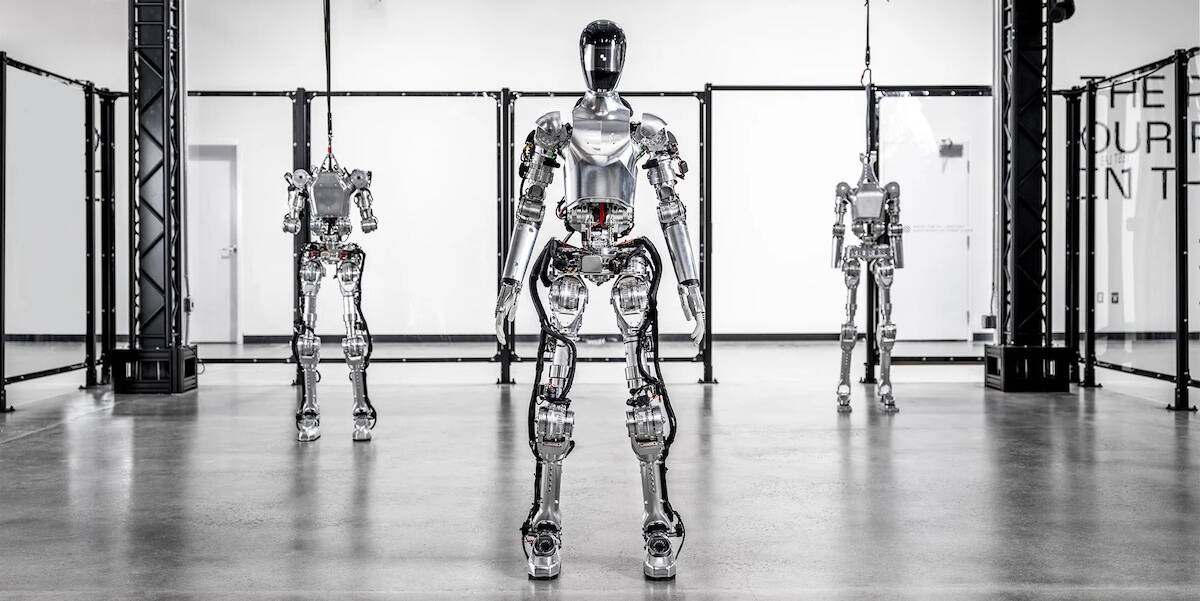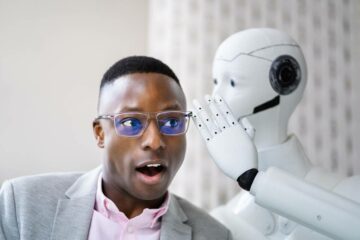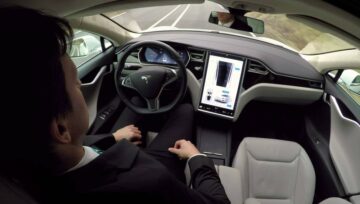
If you thought blue collar jobs were safe from AI, think again. Robotics startup Figure aims to replace millions of workers with its humanoid automatons and has just received $675 million in funding to accelerate development.
The Series B funding round, announced on Thursday, includes contributions from Microsoft, OpenAI, Nvidia, Intel, and Amazon founder Jeff Bezos to name but a few. Each of these companies has a vested interest in AI, robotics, and/or getting rid of those pesky warehouse workers.
Founded in 2022, the Sunnyvale, California-based startup revealed its humanoid robot, Figure 01, last northern spring. The bot is said to be AI-powered, self-reliant, and to be affordable once it goes on sale.
The biz has shown the machine walking, lifting and moving crates around a warehouse environment, and even making a cup of coffee. However, the robot is still slow. Figure’s latest demo, embedded below, shows the machine operating at 16.7 percent of human speed – while tethered.
At that speed, Terminator jokes are redundant – doubly so, in fact, as Figure CEO Brett Adcock’s “Master Plan” states the company won’t “place humanoids in military or defense applications, nor any roles that require inflicting harm on humans.”
It’ll be interesting to see if Figure keeps to that promise or if it’ll disappear from their charter like Google’s “don’t be evil” clause.
The only thing Figure aims to execute with its robots are jobs we flesh bags don’t want to do anyway. It estimates that there are more than 10 million unsafe or undesirable jobs in the US that are ripe for the taking.
Essentially, if it’s a dirty job, Figure wants to do it.
Robots are already pervasive in similar gigs on assembly lines, and increasingly in warehouses and datacenters. However Figure argues these application specific robots lack the flexibility of the human form.
“We could have either millions of different types of robots serving unique tasks or one humanoid robot with a general interface serving millions of tasks. At Figure, we believe general purpose humanoid robots for a human environment is the desired route to have the largest impact,” the outfit opined.
In the near term, Figure is targeting manufacturing, logistics, warehousing, retail, and other areas where the job is well structured and generally repetitive. Back in January, Figure revealed it was working with BMW to identify roles suitable for its robots at its manufacturing facility in Spartanburg, South Carolina.
Figure’s plans to expand robot capabilities to allow hardware to tackle more complex jobs ranging from healthcare to space travel. Eventually it imagines robots replacing manual laborers entirely and even building other robots.
However, Figure doesn’t expect this to happen overnight and says it’s going to require billions of dollars of investment to achieve mass market appeal.
To speed things along, Figure is getting a helping hand from OpenAI, which as part of the funding round, will develop AI models for the startup’s robots.
“We’ve always planned to come back to robotics and we see a path with FIgure to explore what humanoid robots can achieve when powered by highly capable multimodal models,” OpenAI VP of Product and Partnerships Peter Welinder said in a statement.
Meanwhile, Figure says its working with Microsoft on AI infrastructure, training, and storage in Azure. Considering Microsoft’s chumminess with OpenAI, it’s not surprising the software giant would open its systems to a startup like Figure as well, especially when you consider that datacenters are expected to face staffing shortages over the next few years as the bulk of the workforce ages into retirement.
As we reported in October 2023, Microsoft is already exploring the possibility of replacing some datacenter roles with robots.
Figure isn’t the only startup with a foot in the anthropomorphic robot race. Elon Musk’s Tesla has been working on an automaton of its own since 2021 that, like Figure’s, is aimed at dangerous, repetitive, boring tasks – and fractious workers. ®
- SEO Powered Content & PR Distribution. Get Amplified Today.
- PlatoData.Network Vertical Generative Ai. Empower Yourself. Access Here.
- PlatoAiStream. Web3 Intelligence. Knowledge Amplified. Access Here.
- PlatoESG. Carbon, CleanTech, Energy, Environment, Solar, Waste Management. Access Here.
- PlatoHealth. Biotech and Clinical Trials Intelligence. Access Here.
- Source: https://go.theregister.com/feed/www.theregister.com/2024/02/29/figure_human_robot_funding/
- :has
- :is
- :not
- :where
- $10 million
- 01
- 10
- 16
- 2021
- 2022
- 2023
- 7
- a
- accelerate
- Achieve
- affordable
- again
- Ages
- AI
- AI models
- AI-powered
- aimed
- aims
- allow
- along
- already
- always
- Amazon
- an
- and
- any
- anyway
- appeal
- Application
- application specific
- applications
- ARE
- areas
- Argues
- around
- AS
- Assembly
- At
- Azure
- b
- back
- bags
- BE
- been
- believe
- below
- bezos
- billions
- biz
- Blue
- BMW
- Boring
- Bot
- Building
- bulk
- but
- by
- CAN
- capabilities
- capable
- Carolina
- ceo
- CO
- Coffee
- come
- Companies
- company
- complex
- Consider
- considering
- contributions
- could
- Cup
- Dangerous
- Datacenter
- Defense
- Demo
- desired
- develop
- Development
- different
- disappear
- do
- doesn
- dollars
- don
- doubly
- each
- either
- Elon
- Elon Musk
- embedded
- entirely
- Environment
- especially
- estimates
- Ether (ETH)
- Even
- eventually
- execute
- Expand
- expect
- expected
- explore
- Face
- Facility
- fact
- few
- Figure
- Flexibility
- Foot
- For
- form
- founder
- from
- fund
- funding
- Funding Round
- General
- generally
- getting
- giant
- gigs
- Goes
- going
- hand
- happen
- Hardware
- harm
- Have
- healthcare
- helping
- highly
- However
- HTML
- HTTPS
- human
- Humanoid
- Humans
- identify
- if
- imagines
- Impact
- in
- includes
- increasingly
- Infrastructure
- Intel
- interest
- interesting
- Interface
- into
- investment
- isn
- IT
- ITS
- January
- jeff bezos
- Job
- Jobs
- jpg
- just
- Lack
- largest
- Last
- latest
- lifting
- like
- lines
- ll
- logistics
- machine
- Making
- manual
- manufacturing
- Market
- Mass
- Microsoft
- Military
- million
- millions
- models
- more
- moving
- Musk
- name
- Near
- next
- nor
- Nvidia
- october
- of
- on
- once
- ONE
- only
- open
- OpenAI
- operating
- or
- Other
- over
- overnight
- own
- part
- partnerships
- path
- percent
- Peter
- Place
- planned
- plans
- plato
- Plato Data Intelligence
- PlatoData
- possibility
- powered
- PRNewswire
- Product
- promise
- purpose
- Race
- ranging
- received
- redundant
- repetitive
- replace
- Reported
- require
- retail
- retirement
- Revealed
- Rid
- robot
- robotics
- robots
- roles
- round
- Route
- s
- safe
- Said
- sale
- says
- see
- Series
- Series B
- serving
- shown
- Shows
- similar
- since
- slow
- So
- Software
- some
- South
- South carolina
- Space
- Space Travel
- specific
- speed
- spring
- startup
- Statement
- States
- Still
- storage
- structured
- suitable
- surprising
- Systems
- T
- tackle
- taking
- targeting
- tasks
- term
- Tesla
- than
- that
- The
- their
- There.
- These
- thing
- things
- Think
- this
- those
- thought
- thursday
- to
- Training
- travel
- types
- unique
- unsafe
- us
- Ve
- vp
- walking
- want
- wants
- Warehouse
- Warehousing
- was
- we
- WELL
- were
- What
- when
- which
- while
- WHO
- will
- with
- workers
- Workforce
- working
- would
- years
- you
- youtube
- zephyrnet









